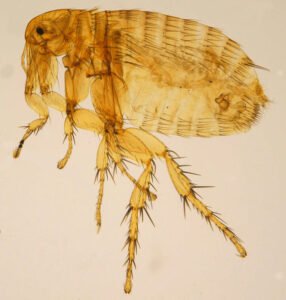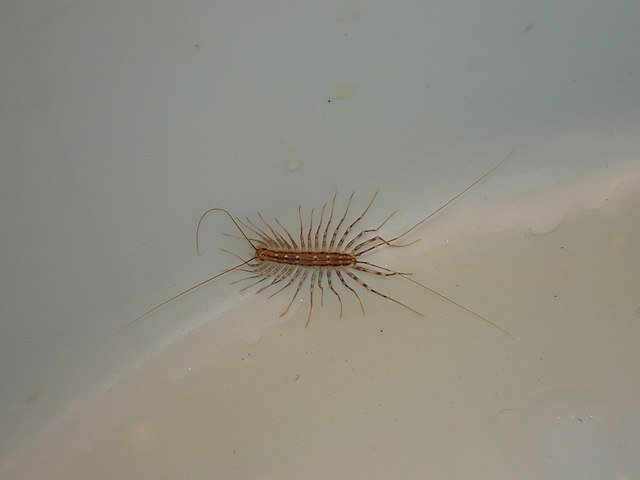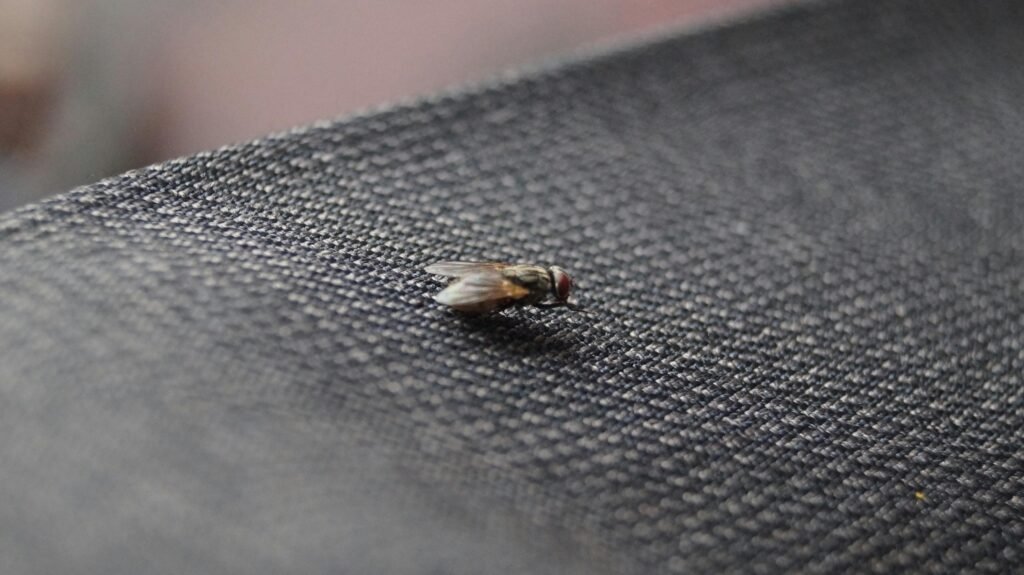Rat Fleas (Xenopsylla cheopis)
 If you’ve ever dealt with a rat infestation, there’s a hidden passenger it carries you should worry about even more — this small insect the rat flea (Xenopsylla cheopis). This tiny insect has shaped human history in terrifying ways, carrying diseases that wiped out millions. I’ve seen infestations where fleas remained active even after the rats were gone, continuing to bite pets and people. Understanding them is not just about pest control — it’s about health and prevention.
If you’ve ever dealt with a rat infestation, there’s a hidden passenger it carries you should worry about even more — this small insect the rat flea (Xenopsylla cheopis). This tiny insect has shaped human history in terrifying ways, carrying diseases that wiped out millions. I’ve seen infestations where fleas remained active even after the rats were gone, continuing to bite pets and people. Understanding them is not just about pest control — it’s about health and prevention.
Identification
The rat flea is small — only 1.5 to 4 mm long — with a dark brown, flattened body built for slipping through fur. Under magnification, you can see:
No genal or pronotal combs (ctenidia) — this separates it from the cat flea (Ctenocephalides felis) and dog flea (Ctenocephalides canis).
Long hind legs designed for jumping.
A piercing-sucking mouthpart specialized for drawing blood.
Unlike human fleas (Pulex irritans), rat fleas are most often found in animal nests, especially where rats (Rattus rattus, Rattus norvegicus) nest and die.
Biology and Ecology
The life cycle of Xenopsylla cheopis includes egg, larva, pupa, and adult stages, lasting about 3–4 weeks under warm, humid conditions (25–30°C).
Eggs: Laid in dust, debris, or rodent bedding.
Larvae: Feed on organic matter, flea feces, and skin flakes.
Pupae: Can stay dormant for months until vibration or carbon dioxide signals a new host.
Adults: Require blood meals every few days.
Their survival depends strongly on rodent populations — when the rats die suddenly (for example, from poison or disease), the starving fleas aggressively seek new hosts, including humans.
This is how outbreaks of plague (Yersinia pestis) historically spread.
Global Distribution
Rat fleas are cosmopolitan, especially in tropical and subtropical regions. They are common in:
Asia and Africa, where plague remains a public health concern in rural areas.
India, Madagascar, and parts of South America, with occasional localized outbreaks.
Southern Europe and the southern USA, where they survive in warmer climates and rodent nests around ports, warehouses, and farms.
Ships carrying infected rats and fleas helped spread plague across the world — from Asia to medieval Europe — and even today, ports remain key risk zones.
Risks and Damage
The primary medical concern is disease transmission:
Bubonic plague (Yersinia pestis) — historically the most devastating flea-borne disease.
Murine typhus (Rickettsia typhi).
Rickettsia felis, recently recognized in human cases.
Even without disease, flea bites can cause:
Allergic dermatitis and severe itching.
Secondary bacterial infections from scratching.
Anemia in heavily infested pets or rodents.
In commercial environments — such as grain storage, farms, or poultry houses — rat fleas can cause contamination and panic among workers.
Signs of Infestation
You rarely see the fleas themselves unless infestation is heavy, but signs include:
Itchy bites on ankles and lower legs.
Tiny black specks (flea feces) in dust or bedding.
Unusual rat behavior or sudden deaths — a signal fleas may be abandoning their hosts.
Movement in rodent nests when disturbed.
A UV flashlight or white sticky traps placed near baseboards or under furniture can help confirm activity.
Control Methods
Flea control must always start with rodent management — otherwise, it’s a losing battle.
Rodent elimination:
Seal entry points and remove food sources.
Use snap traps or professional-grade rodenticides safely.
Environmental treatment:
Vacuum floors, cracks, and corners thoroughly.
Dispose of vacuum bags immediately.
Wash bedding, rugs, and pet blankets in hot water.
Insecticides:
Use residual sprays (pyrethroids, insect growth regulators) targeting cracks, wall voids, and rat harborages.
Do not spray directly on animals.
Pet care:
Treat pets with flea-control products containing fipronil, imidacloprid, or selamectin — but only under veterinary advice.
If infestation continues after rodent removal, foggers or heat treatments may be needed by a licensed pest control technician.
Advanced Approaches
Professionally, I use integrated pest management (IPM) strategies:
Combine rodent proofing, monitoring, and targeted chemical control.
Apply growth regulators to stop larvae from developing.
Use CO₂ traps or light-based monitors to check residual flea presence.
Some newer technologies involve ultra-low-volume (ULV) applications in large facilities or the use of biological controls such as entomopathogenic fungi — though these remain experimental.
Cultural and Historical Context
The story of the rat flea is the story of one of humanity’s deadliest enemies. During the Black Death (14th century), Xenopsylla cheopis carried Yersinia pestis from infected rats to humans, killing nearly one-third of Europe’s population.
In modern times, plague outbreaks in India (1994) and Madagascar (2017) were linked to flea populations following rat die-offs.
Despite sanitation progress, the rat–flea–plague triangle still exists in poorer areas — a reminder of how insects can influence world history.
FAQ Section
1. What does a rat flea look like?
Rat fleas are small, wingless insects about 2–4 mm long, dark brown, with strong jumping legs and no combs on their head or thorax.
2. Can rat fleas bite humans?
Yes. When their rat hosts die or leave, rat fleas readily bite humans and pets, often around the ankles.
3. What diseases do rat fleas spread?
They can carry plague bacteria (Yersinia pestis), murine typhus, and other rickettsial diseases.
4. How do I get rid of rat fleas at home?
Eliminate rats first, clean thoroughly, and apply approved insecticides or contact a licensed pest control company.
5. Can fleas survive without rats?
Adults can survive for several weeks without a blood meal, but long-term survival requires a host.
6. Are rat fleas the same as cat or dog fleas?
No. Cat and dog fleas have combs (ctenidia) and prefer pets. Rat fleas usually live on rodents and only attack humans by accident.
7. Are rat fleas still dangerous today?
Yes — especially in rural areas or developing countries. Even in cities, they can cause bites and allergic reactions.
Final Thoughts
Even though rat fleas are tiny, their impact can be massive — both in history and in modern pest control. I’ve seen infestations start quietly in old storerooms or rat nests, then suddenly explode when the rodents are removed. The key is always prevention: eliminate rodents, clean thoroughly, and treat early before fleas move to people or pets.
If you run a restaurant, warehouse, or farm, regular pest monitoring is essential. For homeowners, keep basements and attics dry, seal every gap, and never underestimate how fast fleas can spread once their host dies.
A well-planned Integrated Pest Management (IPM) approach — combining sanitation, exclusion, and professional chemical control — is the only reliable way to break the rat-flea cycle for good.
Disclaimer
This article is for informational purposes only. Pest control laws and approved chemicals vary by country. For best results and legal safety, we strongly recommend contacting a licensed pest control professional in your local area. Always make sure that the pest control technician is properly certified or licensed, depending on your country’s regulations. It’s important to confirm that they only use approved products and apply them exactly as instructed on the product label. In most places in Europe, UK, or USA, following label directions is not just best practice—it’s the law.
Author
Nasos Iliopoulos
ΒSc Agronomist & Certified Pest Control Expert
Scientific Director, Advance Services (Athens, Greece)
Licensed Pest Control Business – Ministry of Rural Development & Food (GR)
References
PubMed - Rat fleas
Parola, P., & Raoult, D. “Ticks and Fleas as Vectors of Emerging Bacterial Diseases.” Clinical Microbiology Reviews, 2001.


